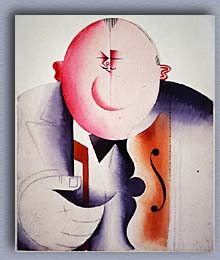

Distortion and provocation had long been elements of caricature and cartoons, but in the early twentieth century, they also suggested artistic innovation. The forceful stylizations of Mexican artist Miguel Covarrubias influenced American caricature in the 1920s as much as Marius de Zayas had in the 1910s. The strong tradition of satiric art in Mexico, where caricature and cartoon had long been used as a weapon for revolutionary change, had convinced both artists of the powerful potential of humor and distortion. In New York City, however, they challenged aesthetic rather than political norms, as they incorporated a modernist vocabulary into their work.
Covarrubias's portrait of famous band leader Paul Whiteman, with its mechanical bisection of the face, abstract features, and musical imagery, spoofs Picasso's cubist works. Whiteman was already renowned for his recordings and his orchestras, but his Aeolian Hall jazz concert in 1924, featuring the first performance of George Gershwin's "Rhapsody in Blue," put his name on everyone's lips. To this sophisticated audience, the witty, high-low juxtaposition of cubist abstraction and cartoon inflation was a recognizable reference to Whiteman's own efforts to merge popular and classical traditions.
Paul Whiteman 1891-1967
BACK to "Experimental Portraiture"
Miguel Covarrubias (1904-1957)
Watercolor over charcoal on cut paper, circa 1924
Prints and Photographs Division,
Library of Congress, Washington, D.C.
NEXT portrait
Home | Information | Collections | Exhibitions | Calendar | Search